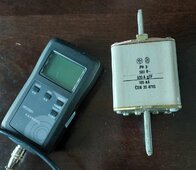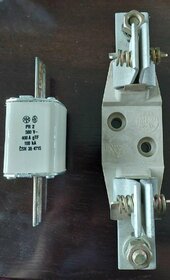I've managed to "score" some fuses made in 1989 in back then still communist Poland.
They measure exactly the same as new ones I have despite the visible tarnish. Likewise for the holders.
I paid 20% of the usual price. There is no "jest before" date for fuses as far as I can tell. The only difference between these and modern NH00 fuses is the contact electrode. One's made today have a so called "knife" (it really looks like a butter knife scaled 10x bigger). These have this wavy things. I'm planning to watch them on a thermal camera when testing to ensure they dont heat up.
The miliohm meter is there to scale. What do you think? gTF is a fast characteristic. Yes, I'm aware they are for AC not DC and I'm going to use them with ~50V DC. But if they have 100kA short braking capability at 500V AC I'm pretty happy with them for DC.



They measure exactly the same as new ones I have despite the visible tarnish. Likewise for the holders.
I paid 20% of the usual price. There is no "jest before" date for fuses as far as I can tell. The only difference between these and modern NH00 fuses is the contact electrode. One's made today have a so called "knife" (it really looks like a butter knife scaled 10x bigger). These have this wavy things. I'm planning to watch them on a thermal camera when testing to ensure they dont heat up.
The miliohm meter is there to scale. What do you think? gTF is a fast characteristic. Yes, I'm aware they are for AC not DC and I'm going to use them with ~50V DC. But if they have 100kA short braking capability at 500V AC I'm pretty happy with them for DC.







